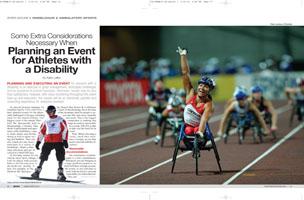
 |
| Photo courtesy of PhotoRun |
Planning and executing an event for persons with a disability is an exercise in good management. Anticipate challenges and be prepared to provide solutions; otherwise, results may be less than satisfactory. However, with close monitoring throughout the event lead-up and execution, the results will be an extremely positive and rewarding experience for everyone involved.
As special projects manager for Disabled Sports USA (DSUSA), I have planned events for the physically challenged of all ages, including many for the injured military. Our biggest event is the annual Hartford Ski Spectacular held in Breckenridge, Colorado. Hundreds of participants and spectators with disabilities come to learn alpine and Nordic skiing as well as alpine racing and biathlon. They can also watch pro-am races, participate in a variety of workshops, obtain continuing education and get involved in a NASTAR race.
 |
| Photo courtesy of Ken Watson/MediaTell, Inc. |
In choosing venues for our various snow sport outings, I look for places with accessibility to ski lifts and snow. A ski-in/ski-out facility is best. For example, at The Hartford Ski Spectacular, Beaver Run Resort & Conference Center at Breckenridge sits at the base of the mountain, ideal for people to access the lifts and snow instantly and easily. That is the biggest component to making this large an event so successful. As a result, DSUSA is able to take over the hotel for its event.
Note: When choosing a venue, check their insurance coverage, as you may need to provide liability insurance.
Reasonable Accommodations
The convenience of participants is a first consideration. Whenever you are bringing in a large disabled population, no hotel will have enough accessible rooms, so you will have to work with the hotel to provide reasonable accommodations. This can range from upgrading from standard-size hotel rooms to a one-bedroom suite or a studio apartment, to removing bathroom doors to enhance wheelchair accessibility. Be sure your hotel can provide the flexibility necessary.
 |
| Photo courtesy of UCO, Endeavor Games, Edmond, OK |
I also check on the availability of shower chairs. If necessary, DSUSA will arrange to provide additional chairs. I also have what I call 'wheelie-chairs,' basically stools with wheels on them so that in a room with narrow doors, an individual can transfer from their wheelchair to the stool, get to the bathroom, and transfer again from the stool to the shower chair.
DSUSA staff members will also do a walk-through prior to the event to make sure elevators are operational and there are ramps to navigate stairs and curbs. If there is a lot of furniture in the lobby, we will ask that it be rearranged to provide an unobstructed pathway for wheelchairs.
It is important to communicate clearly with the hotel administration well in advance so they know what to expect and are prepared for tweaking rooms as needed.
During check-in time, our staff is always available in the hotel lobby, greeting attendees and making sure they know we are here to address any concerns.
 |
| Photo courtesy of Ken Watson/MediaTell, Inc. |
The Banquet/Conference Room
In a banquet or seminar where there will be participants in wheelchairs, the aisles will have to be made wider for easy access. If the venue can seat 500 able-bodied comfortably, that number will go down by approximately 10 percent for accommodating multiple wheelchairs.
Make sure there is open seating. Wheelchair users should be able to sit anywhere whether with another disabled person or a non-disabled person and access the room freely. The stage also should be wheelchair accessible and wide enough to turn a chair around.
Letting Participants Know What to Expect
Prior to the event, a fact sheet is provided for attendees. This includes a description of the hotel accommodations, what ground transportation is available (with phone numbers), what the expected weather conditions will be (including daily highs and lows), and what participants need to do to prepare regarding clothing, medications, etc.
In higher elevations for our alpine ski events, our sheet includes a section on altitude sickness, precautions to take, and when medical help is needed. Warm weather locations can be a challenge for spinal cord patients because they do not sweat, so they need extra hydration and shading. We try to get a local business to sponsor water bottles and personal misters for everyone attending.
 |
| Photo courtesy of UCO, Endeavor Games, Edmond, OK |
If our athletes or participants use medication or personal hygiene items, these should be in a backpack or carry-on, so in case luggage gets lost, meds are still available. This is very important because most people who have a disability will be on medication, especially during rehabilitation.
Providing detailed onsite information is critical. This is particularly important to people with disabilities who have different challenges to overcome in their activities of daily living. A program book containing comprehensive agendas will help them plan their day. Designate an area where daily announcements will be posted so they so individuals can be alerted to any changes in the schedule.
Air and Ground Transportation
When people with disabilities fly, there will always be a delay getting through security as wheelchairs, prostheses, medications and medical supplies always are given a thorough check. With a group, this can be a lengthy process.
 |
| Photo courtesy of Courtesy of Adaptive Sports Association of Durango, a chapter of DSUSA |
When large groups are flying, DSUSA works with TSA in advance, providing them specific times, flight numbers, and how many people with disabilities will be coming through. TSA has set up private check-ins to help us expedite the security process, even providing both a male and female agent for more extensive screenings.
When a wheelchair user boards a plane, assistance is needed to transfer from chair to the airplane seat. Having a person who is knowledgeable about wheelchair transfers can greatly expedite the process. If you are putting together an event with a group from a rehabilitation facility, enlist the help of that facility’s therapists. We make it a requirement to have a 5:1 patient/therapist ratio.
If you are having an event where people will be flying in individually from various locations, ensure there is accessible ground transportation for them. Options include large charter buses, taxi, private car services, and metro/subway with accommodations for people with disabilities. Alert those companies in advance about the special needs of passengers. Consider working with the airport administration to arrange a greeting table or kiosk for your participants near passenger pickup.
 |
| Photo courtesy of UCO, Endeavor Games, Edmond, OK |
Adaptive Equipment and Instruction
Having instructors on hand who are trained or certified in adaptive sports is an important aspect of event planning, since people with new injuries may be unsure of how to participate. For winter sports, there are many members of the PSIA-AASI (Professional Ski Instructors of America and American Association of Snowboard Instructors) who are certified to teach adaptive techniques. Many will volunteer their time to help at disabled events, and only ask for assistance with lodging, lift tickets, and some meals. Warm weather outdoor activities require adaptive instructors in horseback riding, SCUBA, rock climbing, athletics and more. DSUSA’s chapter network (104 chapters in 38 states) can help provide information. Visit www.dsusa.org.
We also ask organizations that supply sports equipment products for people with disabilities to attend and set up tables or tents so participants can see and test adaptive equipment. Adaptive equipment for sports is extremely expensive to purchase. Having the opportunity to look at different options is important so athletes know what will work best for them before they make a major investment.
Volunteers
When working with people with disabilities in a sports setting, it is a great idea to incorporate volunteerism into the event. Volunteers can be utilized for many tasks, both directly working with athletes, and doing general event volunteer work.
Getting People Connected
Helping people who are newly disabled to network with those who have lived with a disability for an extended period of time is perhaps one of the most important functions of the event. Invariably, conversations begin, experiences are shared, and friendships form. The newly disabled learn they can return to an active lifestyle after watching other amputees, paraplegics, or visually-impaired individuals navigate ski slopes, go scuba diving, or learn how to rock climb. A lot of networking happens for people with disabilities when you pull them all together at a major event.

